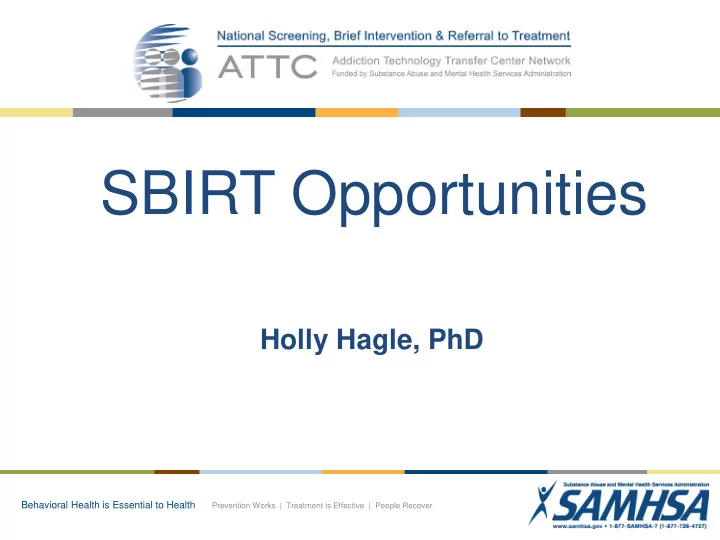

SBIRT Opportunities Holly Hagle, PhD Behavioral Health is Essential to Health Prevention Works | Treatment is Effective | People Recover
What is SBIRT? • SBIRT is a comprehensive, integrated, public health approach to the delivery of early intervention and treatment services for people with substance use disorders and those at-risk of developing them. • Primary care, trauma and emergency departments, hospital inpatient, workplace/EAP, community health other settings provide opportunities BEFORE more severe consequences occur.
Source: Substance Abuse and Mental Health Services Administration. (2011). White paper: Screening, Brief Intervention and Referral to Treatment (SBIRT) in Behavioral Healthcare. Available at: http://www.samhsa.gov/prevention/sbirt/SBIRTwhitepaper.pdf .
Why we need SBIRT: Overview 10 Leading Risk Factors for Disease In Developed Countries Percent of disability-adjusted life years Northwest ATTC iThur presentation: (2012) The World Health Report 2002 Behavioral Health is Essential to Health Prevention Works | Treatment is Effective | People Recover
Source: SAMHSA webinar Health Care Reform: Implications for Behavioral Health Providers http://www.youtube.com/watch?v=D0z1T3CRh_8
Full + screen + Source: Northwest ATTC iThur presentation: (2012)
Screening Screen Target # Assessment Setting Type Population Items (most common) ASSIST -Adults 8 Hazardous, harmful, or dependent Primary Care Interview (WHO) -Validated in drug use (including injection drug many cultures use) and languages AUDIT -Adults and 10 Identifies alcohol problem use and -Different Self-admin, (WHO) adolescents dependence. Can be used as a pre- settings Interview, or -Validated in screen to identify patients in need of -AUDIT C- computerized many cultures full screen/brief intervention Primary Care (3 and languages questions) DAST-10 Adults 10 To identify drug-use problems in Different Self-admin or past year settings Interview CRAFFT Adolescents 6 To identify alcohol and drug abuse, Different Self-admin risky behavior, & consequences of settings use CAGE- Adults and 4 -Signs of dependence, not risky use Primary Care Self-admin or AID youth >16 Interview TWEAK Pregnant 5 -Risky drinking during pregnancy. Primary Care, Self-admin, women Based on CAGE. Women’s Interview, or -Asks about number of drinks one organizations, computerized can tolerate, alcohol dependence, & etc. related problems Source :Pacific Southwest ATTC (2012) SBIRT Curriculum
What is Motivational Interviewing? Brief Intervention • Brief counseling that raises awareness of risks and motivates client toward acknowledgement of problem. • Matching the brief intervention to the persons readiness to change through motivational interviewing techniques • Approach to behavior change that assumes that motivation is fluid and can be influenced • Motivation is influenced in the context of a relationship • Principle tasks are to work with ambivalence and resistance • Goal is to evoke and strengthen personal motivation for change
Referral to Treatment Referral and treatment • Meaningful and real • A referral that the patient is likely to utilize • Best when made to a known and trusted provider • Local resources • Referral to treatment
SBIRT for Quality Improvement • SBIRT for ATODs utilizing brief interventions, especially brief, multi- contact interventions using motivational interviewing to move patients toward behavior change; • Identifying resources and referring patients if they are in need of specialty care
SBIRT for Quality Improvement • Behavioral counseling interventions improve behavioral outcomes for adults with risky/hazardous drinking. • The best evidence of effectiveness is for brief multicontact interventions.
Brief Intervention • SAMHSA defines brief intervention as “a single session or multiple sessions of motivational discussion focused on increasing insight and awareness regarding substance use and motivation toward behavioral change.
Brief Intervention Multicontact • Range from very brief interventions within a primary care visit to multicontact interventions that entail multiple, often more lengthy, visits and nonvisit contacts over an extended period. • BI: – very brief (up to 5 minutes, single contact), – brief (more than 5 and up to 15 minutes, single contact), – extended (beyond 15 minutes, single contact), – brief multicontact (each contact up to 15 minutes), – extended multicontact (some contacts beyond 15 minutes).
Brief Intervention • Can include the following elements: – advice, – feedback, – motivational interviews of varying length and number, or – cognitive behavioral strategies (e.g., self- completed action plans, written health education or self-help materials, drinking diaries, problem-solving exercises to complete at home
SBIRT Cost Benefits • Medicaid costs for working age, disabled clients were $366 lower per member per month for those who received at least a brief intervention compared to a statistically matched sample of clients who were treated in an emergency department but did not get a brief intervention through WASBIRT. • The primary factor contributing to reduced costs appeared to be a reduction 0.12 per member per month inpatient hospital days for stays that originated in an ER visit. (Estee et al., 2010)
SBIRT Cost Benefits • The study calculated a medical care savings of $712 per patient, which resulted from differences in emergency room visits and hospitalizations between groups.
SBIRT Cost Benefits • A simulation model generated from a review of U.S. based studies on screening and healthcare utilization costs showed an estimated cost savings of $89 per injured patient screened and $330 for each patient offered a brief intervention.
Questions/Discussion • Visit: nsbirtattc.org • Email: holly@ireta.org
Recommend
More recommend